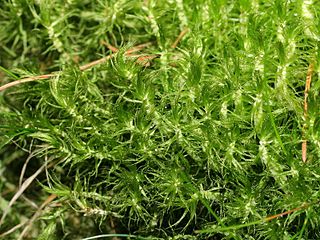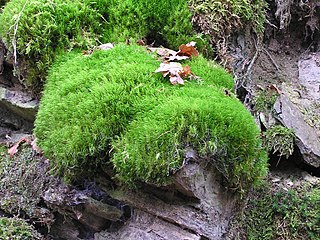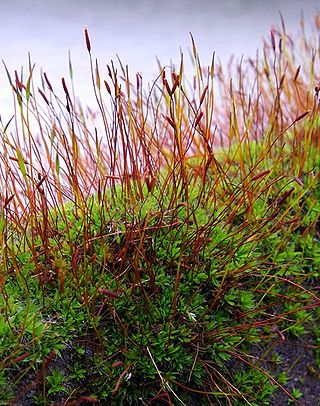
Dicranum is a genus of mosses, also called wind-blown mosses or fork mosses. These mosses form in densely packed clumps. Stems may fork, but do not branch. In general, upright stems will be single but packed together. Dicranum is distributed globally. In North America these are commonly found in Jack pine or Red pine stands.

Dicranaceae is a family of haplolepideous mosses (Dicranidae) in class Bryopsida. Species within this family are dioicous. Genera in this family include Dicranum, Dicranoloma, and Mitrobryum.

Grimmia is a genus of mosses (Bryophyta), originally named by Jakob Friedrich Ehrhart in honour of Johann Friedrich Carl Grimm, a physician and botanist from Gotha, Germany.

Tayloria is a genus of mosses in the family Splachnaceae. It comprises 45 species, divided among 6 subgenera:

Splachnaceae is a family of mosses, containing around 70 species in 6 genera. Around half of those species are entomophilous, using insects to disperse their spores, a characteristic found in no other seedless land plants.

Ditrichum is a genus of haplolepideous mosses (Dicranidae) in the family Ditrichaceae.

Grimmiaceae is a family of mosses in the order Grimmiales.

Schistidium is a plant genus in the moss family Grimmiaceae.

Tortula is a genus of mosses in the family Pottiaceae.

Thuidium is a genus of moss in the family Thuidiaceae. The name comes from the genus Thuja and the Latin suffix -idium, meaning diminutive. This is due to its resemblance to small cedar trees.

Aulacomnium is a genus of mosses of the family Aulacomniaceae, with a circumpolar distribution.

Plagiomnium is a genus of mosses in the family Mniaceae. It was formerly a part of a more encompassing genus Mnium and in 1968 Finish bryologist Timo Juhani Koponen justified splitting the genus into a number of smaller genera.

Plagiothecium is a genus of moss belonging to the family Plagiotheciaceae. It has a cosmopolitan distribution.

Rhynchostegium is a genus of pleurocarpous mosses belonging to the family Brachytheciaceae. The genus has a cosmopolitan distribution across different climatological regions except the polar regions, mostly in tropic to north temperate regions. The genus contains both aquatic and terrestrial species. The genus was named for their rostrate opercula. The type species of this genus is Rhynchostegium confertum (Dicks.) Schimp.

Rhizogonium is a genus of mosses belonging to the family Rhizogoniaceae.
Pylaisia is a genus of mosses belonging to the family Pylaisiaceae.

Ptychostomum is a genus of mosses belonging to the family Bryaceae. It has an almost cosmopolitan distribution.

Mnium is a genus of mosses belonging to the family Mniaceae. The species of this genus are found in Europe and North America.
Leskeaceae is a family of mosses belonging to the order Hypnales.

















